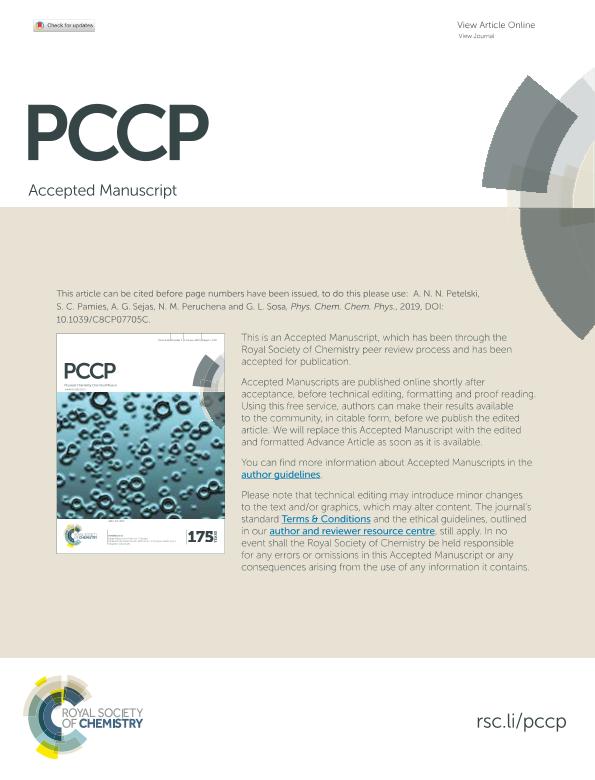Mostrar el registro sencillo del ítem
dc.contributor.author
Petelski, Andre Nicolai

dc.contributor.author
Pamies, Silvana Carina

dc.contributor.author
Sejas, Agustín Gabriel
dc.contributor.author
Peruchena, Nelida Maria

dc.contributor.author
Sosa, Gladis Laura

dc.date.available
2020-06-10T17:15:26Z
dc.date.issued
2019-02
dc.identifier.citation
Petelski, Andre Nicolai; Pamies, Silvana Carina; Sejas, Agustín Gabriel; Peruchena, Nelida Maria; Sosa, Gladis Laura; Impact of Confinement in Multimolecular Inclusion Compounds of Melamine and Cyanuric acid; Royal Society of Chemistry; Physical Chemistry Chemical Physics; 21; 16; 2-2019; 8205-8214
dc.identifier.issn
1463-9076
dc.identifier.uri
http://hdl.handle.net/11336/107189
dc.description.abstract
Supramolecular cavities can be found in clathrates and self-assembling capsules. In these computational experiments, we studied the effect of folding planar hydrogen-bonded supramolecules of melamine (M) and cyanuric acid (CA) into stable cage-like quartets. Based on dispersion-corrected density functional theory calculations at the B97XD/6-311++G(d,p) level, we show the flexibility of M and CA molecules to form free confined spaces. Our bonding analysis indicates that only CA can form a cage which is more stable than their planar systems. We then studied the capacity of the complexes to host ionic and neutral monoatomic species like Na+, Cl- and Ar. The encapsulation energies range from -2 to -65 kcal/mol. A detailed energy decomposition analysis (EDA) support the fact that the triazine ring of CA is superior to the M one to capture chloride ions. In addition, the EDA and the topology of the electron density, by means of the Atoms in Molecules (AIM) theory and electrostatic potential maps, reveal the nature of the host-guest interactions in the confined space. The CA cluster appears to be the best multimolecular inclusion compound because it can host the three species and keep its cage structure, and therefore could also act as a dual receptor of the ionic pair Na+Cl-. We think these findings could inspire the design of new heteromolecular inclusion compounds based on triazines and hydrogen bonds
dc.format
application/pdf
dc.language.iso
eng
dc.publisher
Royal Society of Chemistry

dc.rights
info:eu-repo/semantics/openAccess
dc.rights.uri
https://creativecommons.org/licenses/by-nc-sa/2.5/ar/
dc.subject
MELAMINE
dc.subject
CYANURIC ACID
dc.subject
SUPRAMOLECULES
dc.subject
INCLUSION COMPOUNDS
dc.subject.classification
Físico-Química, Ciencia de los Polímeros, Electroquímica

dc.subject.classification
Ciencias Químicas

dc.subject.classification
CIENCIAS NATURALES Y EXACTAS

dc.title
Impact of Confinement in Multimolecular Inclusion Compounds of Melamine and Cyanuric acid
dc.type
info:eu-repo/semantics/article
dc.type
info:ar-repo/semantics/artículo
dc.type
info:eu-repo/semantics/publishedVersion
dc.date.updated
2020-05-04T15:21:54Z
dc.journal.volume
21
dc.journal.number
16
dc.journal.pagination
8205-8214
dc.journal.pais
Reino Unido

dc.journal.ciudad
Cambridge
dc.description.fil
Fil: Petelski, Andre Nicolai. Consejo Nacional de Investigaciones Científicas y Técnicas. Centro Científico Tecnológico Conicet - Nordeste. Instituto de Química Básica y Aplicada del Nordeste Argentino. Universidad Nacional del Nordeste. Facultad de Ciencias Exactas Naturales y Agrimensura. Instituto de Química Básica y Aplicada del Nordeste Argentino; Argentina. Universidad Tecnológica Nacional. Facultad Regional Resistencia. Departamento de Ingeniería Química. Laboratorio de Química Teórica y Experimental; Argentina
dc.description.fil
Fil: Pamies, Silvana Carina. Universidad Tecnológica Nacional. Facultad Regional Resistencia. Departamento de Ingeniería Química. Laboratorio de Química Teórica y Experimental; Argentina
dc.description.fil
Fil: Sejas, Agustín Gabriel. Universidad Tecnológica Nacional. Facultad Regional Resistencia. Departamento de Ingeniería Química. Laboratorio de Química Teórica y Experimental; Argentina
dc.description.fil
Fil: Peruchena, Nelida Maria. Consejo Nacional de Investigaciones Científicas y Técnicas. Centro Científico Tecnológico Conicet - Nordeste. Instituto de Química Básica y Aplicada del Nordeste Argentino. Universidad Nacional del Nordeste. Facultad de Ciencias Exactas Naturales y Agrimensura. Instituto de Química Básica y Aplicada del Nordeste Argentino; Argentina
dc.description.fil
Fil: Sosa, Gladis Laura. Universidad Tecnológica Nacional. Facultad Regional Resistencia. Departamento de Ingeniería Química. Laboratorio de Química Teórica y Experimental; Argentina. Consejo Nacional de Investigaciones Científicas y Técnicas. Centro Científico Tecnológico Conicet - Nordeste. Instituto de Química Básica y Aplicada del Nordeste Argentino. Universidad Nacional del Nordeste. Facultad de Ciencias Exactas Naturales y Agrimensura. Instituto de Química Básica y Aplicada del Nordeste Argentino; Argentina
dc.journal.title
Physical Chemistry Chemical Physics

dc.relation.alternativeid
info:eu-repo/semantics/altIdentifier/url/http://xlink.rsc.org/?DOI=C8CP07705C
dc.relation.alternativeid
info:eu-repo/semantics/altIdentifier/doi/http://dx.doi.org/10.1039/c8cp07705c
Archivos asociados
